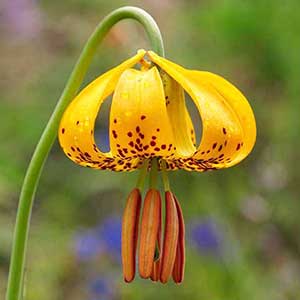Lilium columbianum
Lilium iridollae
Columbia lily, Columbia tiger lily, Columbian lily, Oregon lily, tiger lily
panhandle lily, pot-of-gold lily
variable, subrhizomatous to ± ovoid, 3.1–8.1 × 3.6–10.6 cm, 0.3–1.4 times taller than long;
scales 2–3(–5)-segmented, some unsegmented, longest 3.1–7.3 cm;
stem roots absent.
rhizomatous, often branching, 1.4–2.9 × 9.6–18 cm, 0.1–0.3 times taller than long, 3–4 years’ growth evident as annual bulbs, older growth often with perpendicular thin branches leading to small new bulbs and always with noticeable abscission scars, youngest 3 years’ growth bearing basal leaves, scaleless sections between annual bulbs 2.7–5.4 cm;
scales unsegmented, longest 1–2 cm;
stem roots present or absent.
to 1.7 m, glaucous or not.
to 2 m. Buds ± triangular in cross section.
rounded in cross section.
in 1–9 whorls or partial whorls, 3–25 leaves per whorl, usually ascending, 1.7–15.7 × 0.4–4.7 cm, 2.4–7.4 times longer than wide;
blade weakly oblanceolate to obovate or ± elliptic, margins usually somewhat undulate, apex acute;
veins and margins ± smooth abaxially.
in 1–5 whorls or partial whorls, 3–10 leaves per whorl, ascending, sometimes only slightly, or occasionally ± horizontal and drooping slightly at tips, 3.1–15.7 × 0.5–3.6 cm, 2.1–9.3 times longer than wide;
blade weakly to sometimes narrowly oblanceolate, occasionally obovate, elliptic, or narrowly elliptic, margins not undulate, apex acute, acuminate in distal leaves;
central vein in particular impressed adaxially, veins and margins often somewhat roughened abaxially with tiny ± deltoid epidermal spicules.
racemose, 1–25(–45)-flowered.
umbellate or rarely racemose, 1–4-flowered.
pendent to nodding, not fragrant;
perianth Turk’s-cap-shaped;
sepals and petals reflexed 2/5–1/2 along length from base, yellow or orange to occasionally red, with copious maroon spots, often darker and especially reddish abaxially, not distinctly clawed;
sepals not ridged abaxially, appearing wide for their length, 3.4–7.1 × 0.8–1.9 cm;
petals 3.5–6.9 × 0.8–1.9 cm;
stamens barely to moderately exserted;
filaments moderately spreading, diverging 10°–20° from axis;
anthers pale yellow to yellow, 0.5–1.3 cm;
pollen orange or yellow;
pistil 2.4–3.7 cm;
ovary 1.1–2.2 cm;
style green;
pedicel 2.8–20.2 cm.
pendent, not fragrant;
perianth Turk’s-cap-shaped;
sepals and petals reflexed less than 1/5 along length from base, yellow-orange or yellow, sometimes orange-yellow, often suffused with red distally, spotted maroon, often nearly to apex, not distinctly clawed, nectaries exposed, forming visible green star;
sepals with 2 parallel, often faint abaxial ridges, 6.2–10.2 × 1.1–1.8 cm;
petals 6.1–10 × 1.2–2.2 cm;
stamens strongly exserted;
filaments parallel along much of length, then widely spreading, diverging 14°–31° from axis;
anthers magenta, 1–1.6 cm;
pollen rust or sometimes rust-orange;
pistil 4.7–6.8 cm;
ovary 1.5–2.5 cm;
style very pale green, often spotted purple near apex;
pedicel 10–23 cm.
2.2–5.4 × 1.1–2 cm, 1.7–3.3 times longer than wide.
2.5–5 × 1.7–3 cm, 1.2–2.2 times longer than wide.
135–330.
not counted.
= 24.
Lilium columbianum
Lilium iridollae
The author citations often seen for this species derive from Baker (1874), who published the name as Lilium columbianum “Hanson in hort., Leichtlin”; this authority is given by various later writers as Hanson, or Baker, or Hanson ex Baker. However, Ducharte’s (1871) recapitulation of a letter from M. Leichtlin is apparently the first confirmed and valid publication of L. columbianum, and hence that citation is used here.
This widespread lily is rather variable. In California plants the stamens are considerably less exserted than those of plants found farther north. Lilium columbianum may intergrade with L. kelloggii along Highway 199 at the border between California and Oregon; these plants are slightly fragrant, the stamens moderately exserted, and the bulb scales unsegmented. Lilium columbianum hybridizes with L. pardalinum subspp. wigginsii and vollmeri, and extensively with L. occidentale in Oregon.
Lilium columbianum is pollinated primarily by rufous hummingbirds [Selasphorus rufus (J. F. Gmelin), family Trochilidae] and to a lesser extent by large butterflies, including the pale swallowtail (Papilio eurymedon Lucas, family Papilionidae).
Native Americans used Lilium columbianum bulbs as a food or peppery condiment, sometimes mixed with meat or salmon roe. For many, it was a staple food (J. Pojar and A. MacKinnon 1994).
(Discussion copyrighted by Flora of North America; reprinted with permission.)
Of conservation concern.
As its vernacular name indicates, the panhandle lily is restricted to a small area in the western Florida panhandle and adjacent Alabama, where it has been much reduced in number by land-clearing for pasture and housing. It is now under consideration for federal protection.
Lilium iridollae is allopatrically distributed with its close relative L. superbum, though the latter occurs within 40 miles of the northernmost populations of the panhandle lily. Blooming times are staggered, L. iridollae typically starting to bloom as L. superbum is finishing. Diagnostic features include the usually brighter flower color, less numerous, shorter, noticeably though subtly oblanceolate leaves in five or fewer whorls (L. superbum has six or more), and few flowers, as well as very long rhizomes with basal leaves, as much as four years’ visible growth, and extended scaleless sections between the annual growth bulbs.
Lilium iridollae is pollinated by all the larger swallowtail butterflies within its limited range, especially the spicebush (Papilio troilus Linnaeus, family Papilionidae), eastern tiger (Papilio glaucus, Linnaeus), and palamedes [Papilio palamedes (Drury)].
(Discussion copyrighted by Flora of North America; reprinted with permission.)
- Local floras:
BC,
CA,
OR,
WA
- Local Web sites:
CalFlora,
CalPhotos,
Flora NW,
PNW Herbaria,
Turner Photog.
WildflowerSearch
iNaturalist (observations)
USDA Plants Database
- LBJ Wildflower Center
- SEINet
- Plants of the World Online
- Encyclopedia of Life
- Wikipedia
- Google Image Search


